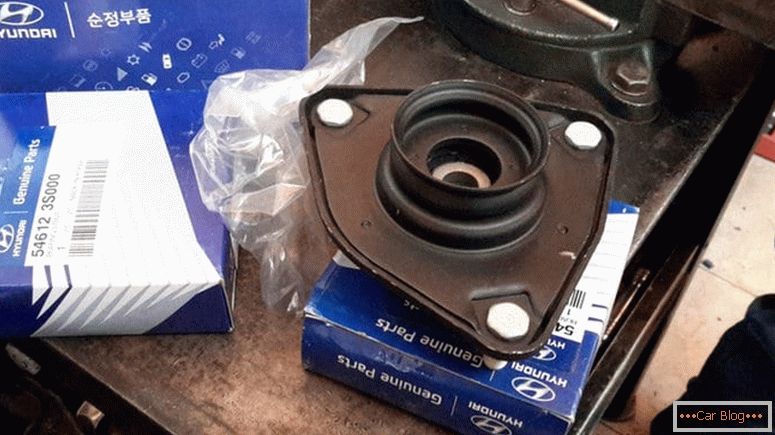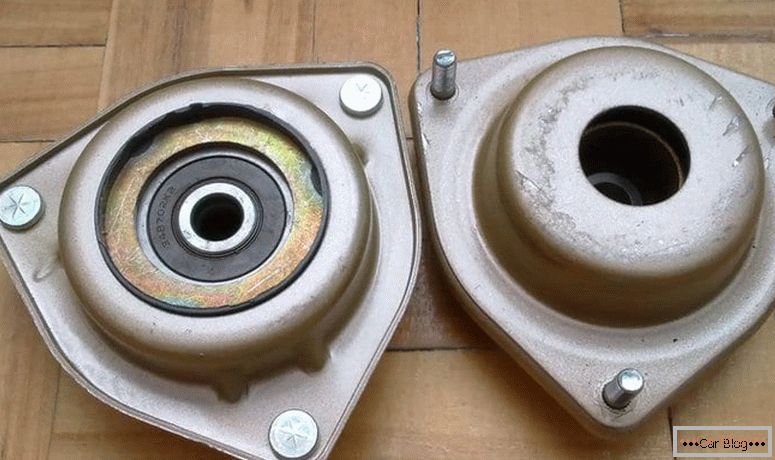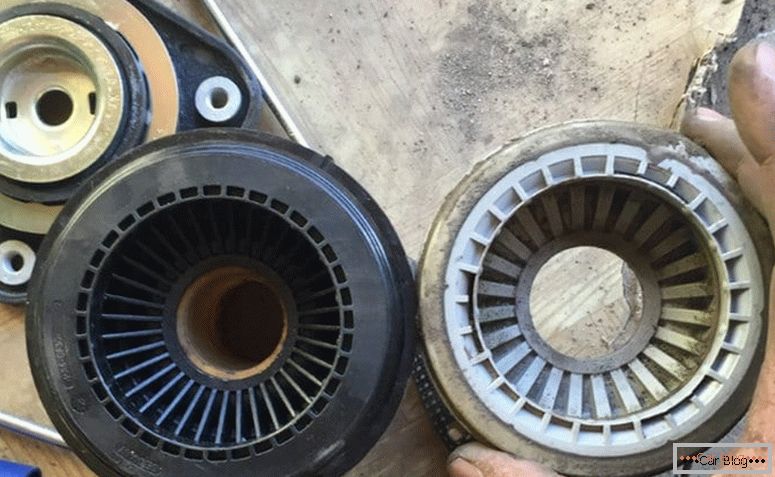The front shock absorber struts are structurally fixed with the vehicle body using upper supports. Special format bearings are also involved in this bundle, helping to balance the resulting loads from the wheel. In order for the car to maintain its operational characteristics, you need to know how to check the support bearings of the uprights.
Content
- 1 Construction features
- 2 The current functionality
- 3 Frequent causes of breakdowns
- 4 Typical damage and their signs
- 5 Self check site
- 6 Important recommendations for extending the life of the opornik
Construction features
Прежде чем разбираться из каких элементов он состоит, необходимо знать, what is thrust bearing. В его задачу не входит функция вращения. Он состоит из резиновой оболочки, внутри которой скрыты классические жесткие стальные шарики. Прорезиненная часть является сепаратором.

Due to the use of plastic material capable of deforming in different directions, inertial loads are extinguished. The distribution of the balls is uniform. Manufacturers offer several varieties of this element:
- with a separable inner ring;
- with integrated rings;
- when the outer ring can be separated;
- in the single split type there is a higher degree of rigidity.
Location area - upper support housing. For VAZ models, the life of this product is set at 80-100 thousand kilometers. However, the replacement must be carried out not only after the deadline, but also on demand, as there is a breakdown often before the release of the established resource.
The current functionality
Based on the name of the product, you can understand why you need a support bearing of the front rack. It serves as a support function and is a type of rolling bearing. The unit is subject to high axial loads, so the metal parts are made of high-strength alloy steel. In extreme road conditions, they wear faster.
It is important to know that signs of a bearing failure in the front pillar must be searched at least every 20 thousand kilometers, the worse the quality of the road surface, the shorter the diagnostic interval should be.
In the tenth family of VAZ in the lower part of the rack is mounted through a rotary cam. In the upper part it is attached directly to the body. Variable mount and is formed by this type of bearings.
See also: How to replace the front axle support bearingFrequent causes of breakdowns
The main problem from which the element fails are problem roads and off-road. Deep sharp holes and high bumps are negatively reflected on it. These barriers create excessive dynamic load on the damping unit. Cars that often travel on such roads need regular inspection.

Another reason is mechanical contamination of the interior of the part. The design does not allow to fully protect it from the negative external effects of dirt and moisture, which are in abundance on the roads.
Some unscrupulous manufacturers lay a small operational resource in their products that are offered in auto shops.. Such parts will serve significantly less than the "native" from the factory.
Typical damage and their signs
Not many novice car enthusiasts know how to determine the failure of the support bearing rack. The main assistant is attentive hearing of the driver. If you hear a knock when turning the steering wheel or while overcoming obstacles such as holes or tussocks, then you need to take note of the front suspension for diagnosis.

When a car has traveled a long distance of several tens of thousands of kilometers on some bearings, then due to the development of a node, control problems may appear. This is manifested in such factors:
- there are troubles in the corners;
- driving performance is reduced;
- maneuverability is lost.
As the thrust bearings knock, the alignment is disrupted. Upon arrival at the inspection pits problems may arise. In extreme cases, the rack is able to pierce the body at the point of attachment. Such a problem will require a more expensive solution. Here not only disassembly / assembly will be involved, but also welding, tin operations and molar work.
Self check site
It should be borne in mind that diagnostics without special equipment and disassembly can show the processes that are the result of other problems not related to the support bearings. In such a situation it is worth being attentive.
See also: There was a thud in the front suspension on the bumps - what to do?The simplest and most popular procedure is the following process:
- the car must be shut down and installed on a flat platform;
- peeking under the open hood;
- remove the cover from the glass hiding the bearing;
- We apply vertical force with the hand on the knot and ask someone to slightly shake the car to the side.
When during the diagnostics an extraneous metal creak and knock is heard, and the stand “walks”, this is a sure sign of replacement.
Important recommendations for extending the life of the opornik
In order for the part to serve as long as possible, it is worth following some rules concerning the operation of the vehicle. It is advisable to avoid driving on uneven sections of the road at high speed. Otherwise, you need to reset it to a minimum.
You should not brake directly in front of the pits or bumps. It is undesirable to allow the penetration of dirt under the support body. It is recommended to periodically inspect and clean the nodes. It is important to at least 1 time in 3 months independently carry out the described diagnostics of the suspension. When installing new bearings, it is not worth saving, but it is better to have branded products with a guarantee.



